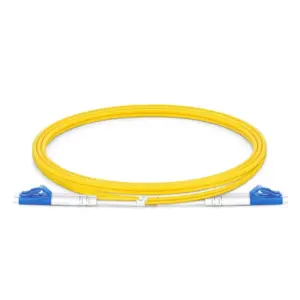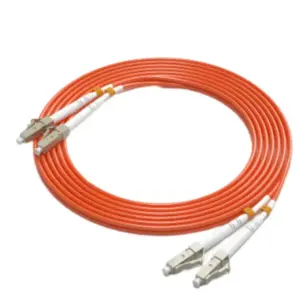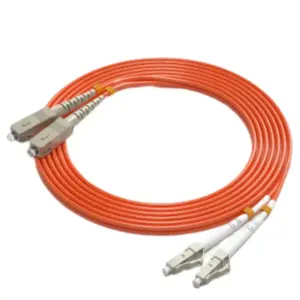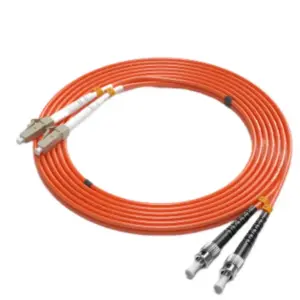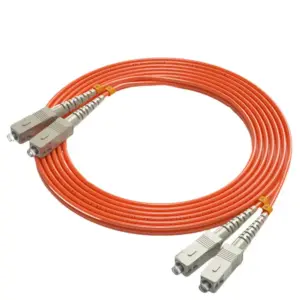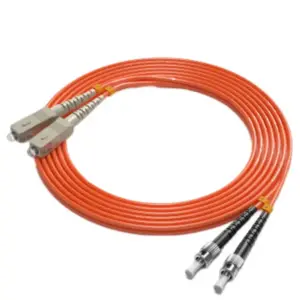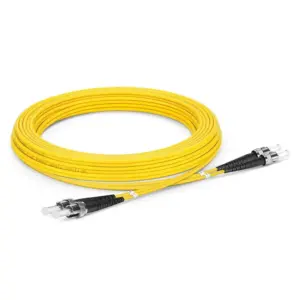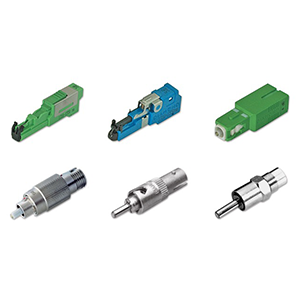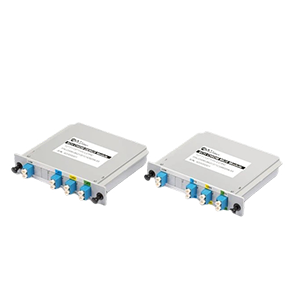I am happy to introduce you to the basic concepts, working principles and applications of multimode optical fiber in different fields. Multimode fiber is a common fiber type with a larger core size that can transmit multiple light signal modes simultaneously.
In this article, we will explore the different types and characteristics of multimode fiber, including the effects of core size and refractive index on optical signal transmission, as well as how bandwidth and attenuation characteristics compare to single-mode fiber.
Multimode optical fiber is widely used in various fields. We will focus on the use of multimode optical fiber in local area networks (LANs), such as data centers and enterprise networks, as well as its use in high-definition video transmission and surveillance systems.
It is important to understand fiber splices and connection methods for multimode fiber. We will explain common multimode fiber optic connector types, such as ST and SC, and provide correct connection methods and precautions.
In addition, we will discuss the performance parameters and limitations of multimode fiber, such as mode distortion and signal attenuation, to help you better understand the characteristics of multimode fiber. At the same time, we will compare the similarities and differences between single-mode fiber and multi-mode fiber in terms of transmission distance, bandwidth and transmission rate to help you choose the fiber type that suits your needs.
Finally, we will look at the future development trends of multimode fiber optics, including emerging applications and challenges in high-speed multimode fiber optic technology and fiber optic data centers. Multimode fiber optics will continue to evolve and innovate to provide reliable solutions for growing data transmission needs.
Introduction to multimode optical fiber
- Introduction to multimode optical fiber
Definition and rationale:
Multimode fiber is a transmission medium used for fiber optic communications in which multiple light signal modes can be transmitted simultaneously. Its core feature is that optical signals are transmitted simultaneously in multiple propagation paths (or modes) in the fiber core.
The working principle of multimode optical fiber is based on the phenomenon of total reflection of light. The optical signal propagates along the optical axis through multiple internal reflections of the light in the fiber core. The relatively large diameter of the fiber core, typically 50 microns or 62.5 microns, allows the optical signal to reflect in multiple paths, creating multiple modes.
Multi-mode transmission:
Multiple modes in multimode fiber can transmit optical signals simultaneously, based on the following principles:
-
Transmission paths: Different modes in multimode fiber correspond to different transmission paths. When an optical signal enters the fiber core, it is reflected at different angles and paths and transmitted inside the fiber core. These different paths correspond to different patterns.
-
Group velocity differences: Different modes in multimode fiber have different propagation speeds. Due to the refractive index profile of the fiber core, different modes experience different group velocities during propagation. This results in a time delay between different modes of optical signals during optical signal transmission.
-
Mode coupling: In multimode fiber, there is a certain degree of coupling between different modes. This means that when an optical signal of one mode reaches the end of the fiber, it may partially couple into other modes. This coupling leads to interference and attenuation between modes.
In practical applications, multimode optical fiber is usually used in shorter-distance communication systems, such as local area networks (LAN) and short-distance data transmission. Due to the simultaneous transmission of multiple modes in multimode optical fiber, the dispersion and attenuation between modes increase, which limits its transmission distance and bandwidth capabilities. In contrast, single-mode optical fiber can support longer transmission distances and higher bandwidths, making it suitable for long-distance communication systems.
In summary, multimode optical fiber realizes the transmission of optical signals through the simultaneous transmission of multiple modes. It provides a cost-effective optical fiber communication solution in specific application scenarios, but its transmission distance and bandwidth capabilities are relatively limited.
Types and characteristics of multimode optical fiber
Core size and refractive index:
Multimode fiber generally comes in two main types, namely 50/125 micron and 62.5/125 micron multimode fiber. These numbers represent the fiber’s core diameter and cladding diameter in microns.
Core size has an important impact on optical signal transmission. The larger core diameter allows multiple modes to be transmitted simultaneously, so 50/125 micron and 62.5/125 micron multimode fiber can support multi-mode transmission. In contrast, single-mode fiber has a smaller core diameter and can only support a single transmission mode.
Another important parameter is the refractive index of the fiber. The refractive index determines the speed at which light signals propagate in optical fibers. Multimode fiber typically has a higher refractive index, causing light signals to travel at a slower speed through the fiber. This results in time delays and dispersion effects between different modes in multimode fiber.
Bandwidth and attenuation:
The bandwidth of a multimode fiber refers to the frequency range of optical signals it can transmit. The bandwidth of multimode fiber is affected by dispersion and attenuation, which limits the effective bandwidth of its transmission.
Chromatic dispersion is a major problem in multimode optical fiber. It is the time spread of different modes of optical signals due to different propagation speeds. This limits the speed and bandwidth of optical signal transmission.
Attenuation is the gradual weakening of optical signals during optical fiber transmission. Attenuation due to inter-mode interference and coupling is more severe in multimode fiber than in single-mode fiber. Therefore, the transmission distance of multimode optical fiber is relatively short and is generally suitable for local area networks and short-distance communications.
Multimode fiber has poorer bandwidth and attenuation characteristics than single-mode fiber. Single-mode fiber has a smaller core diameter and lower refractive index, allowing it to support higher bandwidth and longer transmission distances. Therefore, single-mode fiber is more suitable in applications that require high bandwidth and long-distance transmission.
Multimode optical fiber is characterized by its larger core size, which can support simultaneous transmission of multiple transmission modes. However, multimode fiber has lower bandwidth and larger attenuation, making it suitable for specific application scenarios such as short-distance communications and local area networks. Single-mode fiber has smaller core size and lower attenuation, making it suitable for long-distance and high-bandwidth communication systems.
Application fields of multimode optical fiber
Local Area Network (LAN):
Multimode optical fiber is widely used in local area networks, especially in data centers and enterprise networks. Here are some of the main applications of multimode fiber in these areas:
-
Data Center Interconnect: Data centers typically require high bandwidth and fast data transmission to support large-scale data exchange and processing. Multimode optical fiber provides an efficient and reliable solution for connecting servers, storage devices and network equipment in data centers for fast data transmission.
-
Enterprise Networks: Multimode optical fiber is used in enterprise networks to establish high-speed and reliable communication links. It can connect different floors, different buildings and remote office locations to support large-scale data transmission and communication needs.
-
Video conferencing and audio and video transmission: Multimode optical fiber plays an important role in video conferencing and audio and video transmission. It can provide high-bandwidth and low-latency transmission capabilities to ensure real-time transmission and interaction of high-definition video and high-quality audio.
Video transmission:
Multimode optical fiber is widely used in high-definition video transmission and surveillance systems. The following are some of the main applications of multimode optical fiber in video transmission:
-
High-definition video transmission: Multi-mode optical fiber can provide sufficient bandwidth and transmission speed for transmitting high-definition video signals. It is widely used in television broadcasting, film production, video surveillance and video distribution.
-
Video surveillance system: Multimode optical fiber is used in video surveillance systems to connect cameras and surveillance centers. It can transmit large amounts of video data and support real-time monitoring and remote access. Multimode fiber’s high bandwidth and interference immunity make it ideal for use in surveillance systems.
-
Video display and large screen: Multimode optical fiber also plays an important role in video display and large screen applications. It can transmit high-quality video signals and reduce signal attenuation and dispersion during long-distance transmission.
Multi-mode optical fiber is widely used in local area networks, data centers, enterprise networks and video transmission fields. It provides high bandwidth, fast data transmission and high-quality video transmission capabilities to meet the needs of modern communication and media applications.
Fiber optic splices and connections for multimode fiber
ST and SC connectors:
ST connector (Straight Tip) and SC connector (Subscriber Connector) are common types of multi-mode optical fiber connectors. They have the following characteristics and uses:
ST Connector:
- The ST connector is a cylindrical connector with a ceramic or metal plug with a radius of 2.5 mm.
- It features a rotation locking mechanism that securely holds the fiber optic connection in the connector by rotating the plug.
- ST connectors are commonly used in long-distance transmission and data communication fields of multi-mode optical fiber, such as local area networks, data centers and enterprise networks.
SC Connector:
- The SC connector is a square connector with a 2.5mm ceramic plug.
- It uses a push-pull mechanism that allows you to connect and disconnect fiber optics by pushing in and pulling out the plug.
- SC connectors are commonly used in short-distance communication and data transmission applications with multi-mode optical fiber and single-mode optical fiber, such as LAN, Fiber to the Home (FTTH) and Fiber to the Computer Room (FTTP), etc.
Fiber optic connection:
When making multimode fiber connections, the following are some correct connection methods and precautions:
-
Cleaving and Cleaning: Before connecting, make sure the fiber end face is clean and smooth. Use appropriate tools and methods to cut the fiber, and use pure solvent and clean cotton balls to clean the fiber end face.
-
Align and insert: Align the connector plug with the fiber end face and push gently into the connector socket. Make sure the plug is inserted correctly and is not twisted or tilted.
-
Lock and secure: Depending on the connector type, the connector is secured in the socket by a rotation lock (ST connector) or push lock (SC connector) mechanism. Make sure the connection is tight and avoid looseness.
-
Avoid bending and tension: During the fiber connection process, avoid excessive bending or applying excessive tension to avoid damaging the fiber or connector.
-
Protection and Marking: Use appropriate protective sleeves or sheaths to protect connections from the outside environment. Additionally, identify and document the location and purpose of connections for subsequent maintenance and troubleshooting.
Correct fiber optic connections and precautions are critical to ensuring the quality and reliability of optical signal transmission. Following correct connection steps and precautions can reduce fiber connection damage and signal loss and ensure good connection performance.
Performance parameters and limitations of multimode fiber
Mode distortion:
Mode distortion in multimode fiber refers to signal distortion caused by different propagation modes of light (i.e., light beams propagate in different paths). Common mode distortions in multimode fiber include:
-
Group delay distortion: Due to different propagation paths, the components of the optical signal arrive at the end point at different times, causing signal distortion and distortion. This can lead to pulse spreading and distortion in transmission.
-
Chromatic dispersion: Chromatic dispersion in multimode optical fiber refers to the difference in propagation speed of optical signals of different optical frequencies caused by the change of the refractive index of light with frequency. This causes optical signals with different frequency components to be spread and distorted during transmission.
-
Multi-mode interference: Interference phenomena may occur between different modes in multi-mode optical fiber, resulting in changes in the amplitude and phase of the signal. This can lead to waveform distortion and distortion of the transmitted signal.
These modal distortion phenomena can have a negative impact on signal transmission in multimode optical fiber, limiting its transmission performance and distance.
Signal attenuation:
Signal attenuation in multimode optical fiber refers to the phenomenon that the intensity of optical signals gradually weakens during transmission. Causes and limitations of signal attenuation include:
-
Fiber material absorption: Light signals in multimode optical fibers may be absorbed by the fiber material, causing the signal strength to weaken. Material absorption is mainly related to the characteristics of the optical fiber material.
-
Scattering loss: The optical signal in the multi-mode fiber may be scattered during the transmission process, and part of the optical signal is scattered from the fiber surface and lost. Scattering loss is related to the quality and surface smoothness of the fiber.
-
Core diameter limitation: Optical signals in multimode fibers propagate in multiple modes in the core, with higher-order modes (higher transmission angles) experiencing greater attenuation during transmission. This limits the transmission distance of multimode fiber.
Signal attenuation will cause the intensity of the optical signal to decrease, thereby limiting the transmission distance and reliability of multimode fiber.
Understanding the effects of mode distortion and signal attenuation on multimode fiber is an important consideration when designing and deploying fiber optic communications systems. By taking appropriate compensation and correction measures, these effects can be reduced and the transmission performance of multimode fiber improved.
Comparison between single-mode fiber and multi-mode fiber
Transmission distance:
There are obvious differences in transmission distance between single-mode fiber and multi-mode fiber.
Single mode fiber:
- The core diameter of single-mode fiber is very small, usually 9 microns. Since the fiber core is very small, the beam can only propagate in the dominant mode (low transmission angle).
- Single-mode optical fiber has a long transmission distance, which can reach tens or even hundreds of kilometers, and can maintain low signal attenuation and small mode distortion.
Multimode optical fiber:
- Multimode fiber has a relatively large core diameter, usually 50 or 62.5 microns. The fiber core is larger and the beam can propagate in multiple modes (multiple transmission angles).
- Due to inter-mode dispersion and attenuation problems in multi-mode optical fiber, its transmission distance is relatively short. Usually several hundred meters to several thousand metersrange, depending on factors such as fiber quality and the light source used.
Bandwidth and speed:
There are also differences in bandwidth and transmission rates between single-mode fiber and multi-mode fiber.
Single mode fiber:
- Single-mode fiber has higher bandwidth and transmission rate. Since single-mode fiber only supports main mode propagation, optical signals propagate faster and can transmit higher-frequency optical signals.
- Single-mode optical fiber is usually used in high-speed optical communication systems, supporting data transmission rates up to tens of Gbps or even hundreds of Gbps.
Multimode optical fiber:
- Multimode fiber has lower bandwidth and transmission rates. Since multimode fiber supports multiple modes of propagation, optical signals of different modes will propagate at different speeds, resulting in signal diffusion and distortion.
- Multimode optical fiber is typically used for lower-rate data transmission, such as local area networks (LANs) and short-distance communication applications, supporting transmission rates typically in the range of tens of Mbps to several Gbps.
Single-mode optical fiber has advantages in transmission distance and transmission rate, and is suitable for long-distance and high-speed optical communications. Multimode fiber is suitable for shorter distance and lower speed communication needs. Selecting the appropriate fiber type should be determined by the needs and budget of the specific application.
The future development of multimode optical fiber
High-speed multimode fiber:
High-speed multimode optical fiber technology refers to the ability to achieve higher transmission rates and bandwidth in multimode optical fibers. The following are the development trends and application prospects of high-speed multimode optical fiber technology:
-
OM5 multimode fiber: OM5 multimode fiber is a new multimode fiber standard, also known as WBMMF (Wideband Multimode Fiber). It provides greater bandwidth capabilities by using wavelength division multiplexing technology, supporting transmission rates up to 100Gbps and 400Gbps. OM5 multimode fiber is in growing demand in data centers and short-range communications applications.
-
High-speed transmission technology in multi-mode optical fiber: Researchers have been working hard to improve the transmission rate and bandwidth in multi-mode optical fiber. By using advanced modulation and demodulation technology, improvements in optical fiber materials, and signal processing technology, higher transmission rates, such as 800Gbps and 1Tbps, can be achieved.
-
Application prospects of high-speed multi-mode optical fiber: High-speed multi-mode optical fiber technology has broad application prospects in data centers, cloud computing, high-performance computing, virtual reality and other fields. As the demand for data centers and cloud services continues to grow, so does the need for high-speed, large-bandwidth communication solutions, and high-speed multimode fiber can meet these needs.
Fiber optic data center:
Fiber optic data centers refer to data centers that use fiber optic technology for data transmission and connections. Multimode fiber has emerging applications and challenges in fiber optic data centers, as follows:
-
High-density connections: Fiber optic data centers need to support high-density connections between large numbers of servers and devices. Multimode fiber provides the advantage of making it easier to achieve high-density connections through its larger core diameter and standardization of plug-in interfaces.
-
Challenges of multimode fiber: In fiber optic data centers, multimode fiber faces several challenges. Due to the inter-mode dispersion and attenuation problems in multi-mode optical fiber, as the transmission rate increases, more complex modulation and demodulation technology and signal processing technology need to be used to overcome these problems.
-
Parallel optical communication: Multimode optical fiber is widely used in parallel optical communication systems in data centers. By using multiple optical channels, multiple data streams can be transmitted simultaneously, improving the overall transmission capacity and efficiency of the data center.
The development of optical fiber data centers has put forward higher requirements for multi-mode optical fiber, promoting the development and application of high-speed multi-mode optical fiber technology. As technology continues to advance and demand grows, multimode fiber will continue to play an important role in fiber optic data centers.
Summary:
By reading this article, you will have a deeper understanding of the definition, working principle and application areas of multimode optical fiber. Multimode optical fiber plays an important role in local area networks, video transmission and other fields. Proper fiber splices and connection methods will ensure you take full advantage of multimode fiber.
In the future, high-speed multimode optical fiber technology will continue to develop to meet the growing demand for data transmission. Fiber optic data centers will also become an emerging application area for multimode optical fiber. We look forward to exploring the frontier of multimode optical fiber technology with you and providing you with reliable communication solutions.
-
Customized Multimode Duplex Fiber Optic Patch Cords
-
LC-LC Multimode Duplex Fiber Optic Patch Cord
-
LC-SC Multimode Duplex Fiber Optic Patch Cord
-
LC-ST Multimode Duplex Fiber Optic Patch Cord
-
SC-SC Multimode Duplex Fiber Optic Patch Cord
-
ST-SC Multimode Duplex Fiber Optic Patch Cord
-
ST-ST Multimode Duplex Fiber Optic Patch Cord


